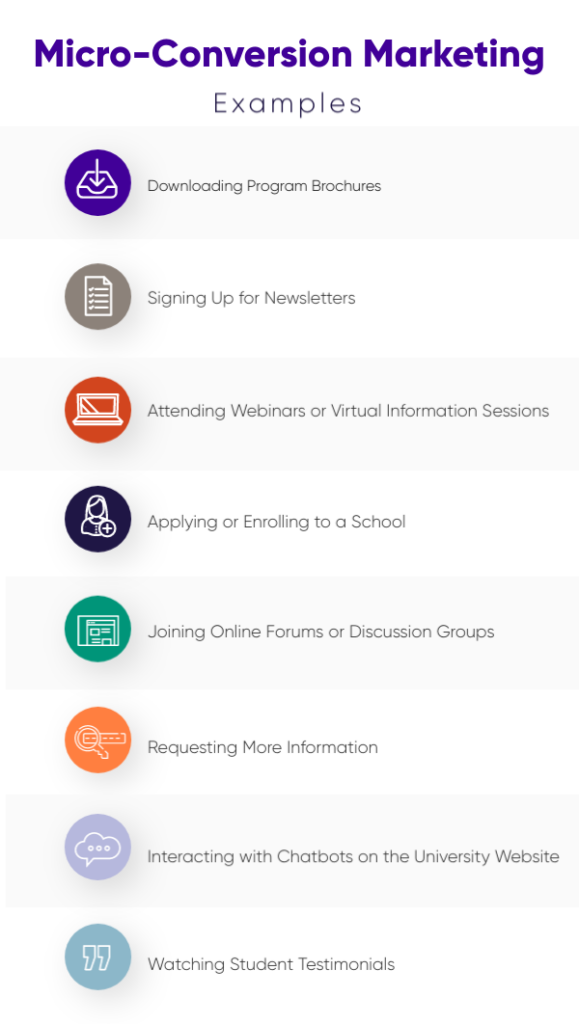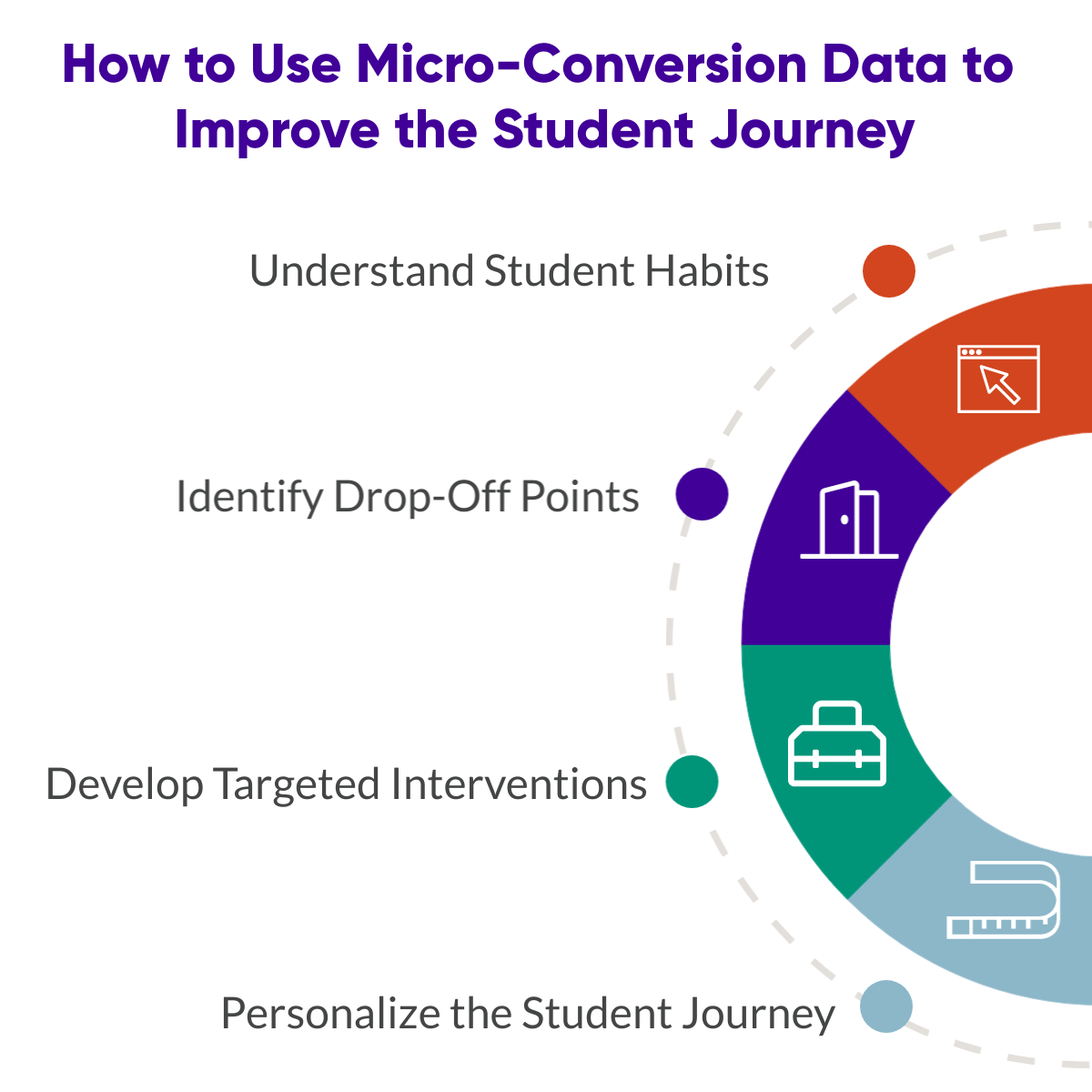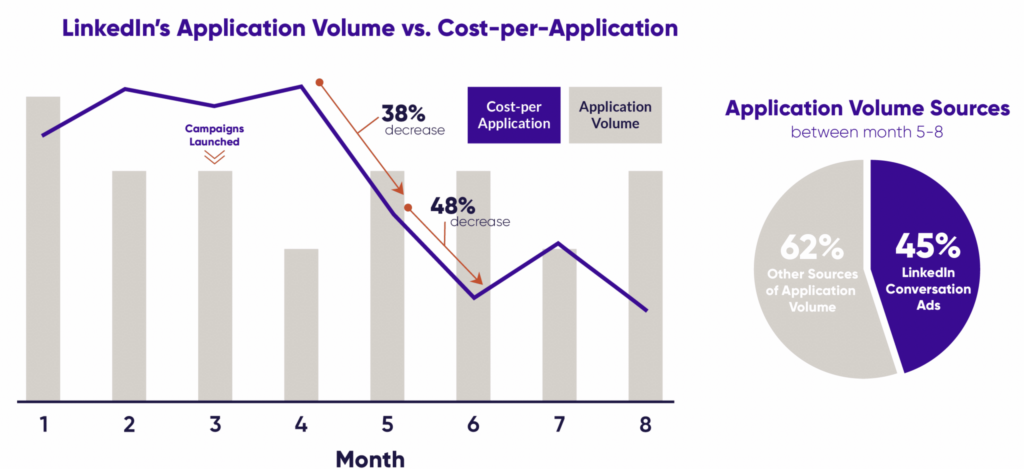Improving the Student Journey with Micro-Conversion Marketing

The Significance of Micro-Conversion Marketing in Higher Ed
The behavior of students researching before enrolling in a college or university is well-documented. It’s interesting to note that more and more students are putting in significant time researching their options online, sometimes months or even years before enrolling. The 2023 Online College Students report revealed that 61% of undergraduate and graduate students searched on Google or other search engines when researching schools, exploring information before deciding to enroll or fill out any forms.
Understanding the nuances of student behavior during this pre-enrollment phase is crucial for higher education marketers like you looking to optimize the overall student journey. This insight is where the concept of micro-conversions becomes vital.
Micro-conversions, which are small but meaningful actions taken by students, provide valuable insights into their preferences, interests, and levels of engagement. Tracking micro-conversions allows you to understand how potential students interact with the website and marketing materials. This data goes beyond measuring effectiveness, empowering you to adapt strategies for a personalized approach that resonates with your prospective student audience’s diverse interests and engagement levels.
How to Track and Measure Micro-Conversions
There are various tools and analytics that effectively track and measure micro-conversions. As a higher education marketer, you can access tools like Google Analytics, heatmaps, and conversion tracking, which allow you to monitor specific actions such as brochure downloads, webinar attendance, or form submissions.
These tools help you pinpoint the most engaging elements on your website, enabling a detailed analysis of user interactions and preferences.

By setting up goals and events in analytics platforms, you can precisely measure the success of the micro-conversion. For example, you can track the specific form completions, the duration of engagement with certain content, or the click-through rates on critical calls to action. This granular data empowers you to assess the effectiveness of different marketing channels and campaigns, guiding strategic decisions to optimize outreach efforts.
Here are some standard methods used to track and measure micro-conversions in higher education marketing:
- Website Analytics: Use analytics platforms to track user behavior on the university’s website. They can monitor specific pages, time spent on site, interactions with forms, and downloads of brochures or other materials.
- Event Tracking: Set up event tracking for specific actions, such as clicking a webinar registration button or completing a quiz. This helps measure engagement with interactive content.
- Email Marketing Metrics: Analyze email open rates, click-through rates, and engagement with embedded links. They can track actions like clicking links to webinars, virtual tours, or downloadable resources.
- Social Media Analytics: Monitor social media interactions, including likes, shares, comments, and clicks on links leading to specific landing pages or micro-conversion forms
- Form Submissions: Track the number of form submissions, including requests for more information, sign-ups for newsletters, or completion of pre-application forms.
- Lead Scoring: Assign scores to different micro-conversions based on their significance. Assign higher scores to actions closer to the ultimate conversion.
- CRM (Customer Relationship Management) Systems: Integration with CRM systems allows you to track and manage leads, recording interactions and engagements at each stage of the student journey.
- Interactive Content Metrics: Track user engagement with interactive content, such as quiz completion rates, time spent on virtual tours, or simulation interactions.
- Chatbot Interaction Data: Leverage chatbots on websites to engage with prospective students. Interaction data can include frequently asked questions, specific queries, and the effectiveness of guiding users toward micro-conversions.
- Surveys and Feedback Forms: Use surveys to gather student feedback and insights, understanding their preferences, concerns, and the effectiveness of various engagement strategies.
- Heatmaps: Use heatmaps to visualize user interactions on webpages, identifying areas of high engagement, such as clicks on specific buttons or links.
- Conversion Rate Optimization (CRO) Testing: Conduct A/B tests on different web pages or content elements to identify what leads to higher micro-conversion rates.
By combining data from these tracking methods, you can comprehensively understand the student journey, optimize their strategies, and ultimately drive successful macro-conversions, such as completed applications and enrollments.
How to Use Micro-Conversion Data to Improve the Student Journey
Mastering these interactions equips you with the ability to refine the student experience and drive more macro-conversions.
Here are some strategies for using micro-conversion data to improve the student journey:

Understand Student Habits
While on university websites, students’ actions and habits offer insightful details that allow you to use this data to understand how they interact with their website, such as using the search option, engagement with CTAs, and other key actions.
Identify Drop-Off Points
By understanding where students drop off or leave the website, you can optimize your campaigns to improve their student journey and increase conversion rates.
Develop Targeted Interventions
Leverage micro-conversion data to develop interventions that provide personalized communication, customized content, and optimized ad types to support the student journey and drive more macro-conversions.
Personalize the Student Journey
Here are several approaches for incorporating micro-conversion marketing to tailor the student experience.
- Personalize Communication: Send targeted emails, messages, and content based on specific micro-conversions, like brochure downloads or webinar attendance.
- Customize Content: Create tailored content addressing individual needs and interests, such as program-specific information for those interested in a particular field of study.
- Retarget and Remarket: Develop targeted campaigns to re-engage students based on prior interactions, displaying ads for specific programs or events to those who visited related website pages.
- Optimize User Experience: Utilize micro-conversion data to enhance the user experience, optimizing journeys with personalized landing pages or website customization based on individual interests.
- Segment and Target: Segment prospective students based on micro-conversions to deliver targeted interventions and personalized experiences throughout the enrollment journey.
Real Results with Micro-Conversions
The effectiveness of micro-conversion marketing is evident through increased engagement, enhanced personalization, higher conversion rates, and data-driven decision-making. When closely examined, it is impactful in increasing program applications within existing budgets.
Recently, EducationDynamics (EDDY) launched a collaborative initiative on LinkedIn to put these micro-conversation strategies to the test. EDDY’s marketing team recognized a greater opportunity for engaging prospective students already considering a graduate law school’s master’s program. This initiative aimed to improve a client institution’s graduate law school master’s program applications.
The strategy involved different ad types on LinkedIn, including conversation ads, leveraging them as a nurturing platform to target strategically identified audiences. These ads encouraged potential students to re-engage directly with the school, contributing to the larger goal of application submission.
The targeted campaigns significantly reduced their cost-per-application by 48%, and 45% of the generated application volume was attributed directly to LinkedIn.
Read more about the success story in our case study, Leveraging LinkedIn for Retargeting and Nurturing.

Want to Implement Micro-Conversion Marketing?
Harnessing micro-conversion data to personalize the student experience is a pivotal strategy for higher education institutions. This approach enables institutions to meet the unique needs of individual students, fostering an environment conducive to their success. If your institution is eager to enhance the student journey and drive enrollment growth through micro-conversion marketing, EducationDynamics’ seasoned marketing team is ready to assist. Reach out to our experts today to embark on a journey towards enrollment growth.